ACQ Wood Preservative and Fasteners-Are They Compatible?
Roofing systems contain treated wood in several applications, such as wood blocking. For many years, wood treated with chromated copper arsenate (CCA) preservative was the industry standard. Exterior wood is subjected to all kinds of hazards: weather conditions, decay, fungi and insect infestation. Over 80 years ago Dr. Karl Wolman invented a process to treat and protect the wood from the environment. Using a pressurized holding tank filled with wood and preservative, Wolman discovered a way to force the preservative into the wood. This process, which has been coined "Wolmanized," increased the service life of wood used in outdoor construction, such as roofing. Unfortunately, the process hasn't been without its share of challenges and changes.
In the beginning, CCA became the most commonly used preservative and was employed for decades. However, the EPA raised environmental concerns about the arsenic and chromium in CCA. Chromium is a heavy metal that can leach into the soil, and depending on the dosage, arsenic can be a lethal poison and is a carcinogen. The arsenic in CCA wood can become airborne during sawing or burning. Raising other concerns is the exposure to children using playground equipment constructed with CCA-treated wood.
To address these environmental issues, researchers began experimenting with other types of wood preservatives until they developed alkaline copper quaternary (ACQ), which is the preferred preservative used today. The main active ingredients in ACQ are copper oxide and a quaternary ammonium compound, also referred to as quat, a fungicide that destroys decay organisms such as fungi and termites.
Though this preservative mix has proven to be the most effective so far, ACQ poses its own concerns. Similar to its predecessor, ACQ also leaches into water tables and leach tests using ACQ wood in wetlands have shown elevated levels of copper in rainwater run-off, soil and sediment. ACQ doesn't have the arsenic or chromium issues of CCA, but it does have triple the amount of copper-a substantial increase.
Despite the problems and setbacks, wood and how it is fastened is a critical part of the roofing process. Even today, researchers continue to ensure that fasteners can stand up to the rigors of ACQ-treated wood. The factors impacted by the preservation of wood are numerous and are exacerbated by non-standardized testing, the types of metals used, and the lack of long-term data collection.
Corrosion Impact
The increased amount of copper in ACQ-treated wood vs. CCA-treated wood impacts the amount of corrosion on certain types of fasteners. Galvanic corrosion occurs when dissimilar metals come into contact with one another and then are exposed to moisture. An electrochemical reaction occurs between these two disparate metals. Like an electrical seesaw, one material loses electrons and corrodes as the anode, while the other one gains electrons as the cathode. Galvanic series charts summarize the potential for this activity and show that the further apart two metals are, the greater the potential for galvanic corrosion. Copper and carbon steel are on opposite ends of the chart. This explains why the high content of copper in ACQ-treated wood can accelerate the corrosion of certain types of fasteners.
There are many years of field life experience with fasteners installed into CCA-treated wood that show fasteners do have a long service life. An added benefit of CCA is that it contains chromium, which is a corrosion inhibitor. Exposing certain types of roofing fasteners to the high amounts of copper in ACQ and additional amounts during leach-out of the copper during rainfall causes a galvanic corrosion concern. The potential of galvanic corrosion depends on the types of metals that are in contact with each other. Another potential concern is the durability of the typical coating on a fastener. When a coated fastener is installed into a substrate such as wood there is a potential for the abrasion to remove some of the protective coating. Small areas that are missing coating can experience more galvanic corrosion than if there were no coating on the fastener. The smaller the unprotected exposed "anode" area is in relation to the larger "cathode" copper surface area in ACQ wood can accelerate galvanic corrosion in the unprotected area. This area can be located within the fastener threads.
Lack of Standard Testing
Though numerous companies have conducted corrosion testing, no standards organization has established a corrosion test to measure fastener or deck corrosion in ACQ-treated wood. Tests vary from conducting the test while the fastener is fully installed into ACQ wood to not having the fastener installed at all. Variations also occur between exposure to an ACQ slurry or extract. To further complicate the results, a non-driven fastener that has all of its coating intact resists corrosion more than a fastener with a non durable coating driven into wood because some of the protective coating can be removed or reduced when the fastener is installed. Some ACQ corrosion tests are conducted on non-driven fasteners, which can produce misleading results. Because test methods vary, strict care must be taken to review the method as well as the results.
Testing conclusions can be stated as pass-fail criteria or they can show hours of exposure during the test, creating doubt as to the answer to the critical question of field service: How many years will the fastener resist corrosion when installed in ACQ-treated wood? Another factor is moisture. Galvanic corrosion can fluctuate widely depending on the amount of moisture the fastener and ACQ wood are exposed to during their service life. Predicting the amount of that moisture over the years of service life is also problematic. Therefore, when reviewing the results, all these aspects should be considered.
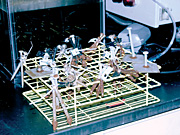
Types of Available Fasteners
There are so many types of fasteners and coatings available that some users are not sure which is the optimum solution for their application. Since there is a lack of long service life history using fasteners in ACQ-treated wood, many people are taking a conservative approach when it comes to fasteners. Aluminum and Galvalume® materials are not compatible with ACQ-treated wood and should never be used. Some manufacturers have addressed the ACQ corrosion issue with proprietary coated carbon steel fasteners or hot-dipped galvanized fasteners. Others are using 300 series or 400 series stainless steel fasteners, while still others use plastic bushings.Each product, presumably, has passed corrosion testing of some sort. Testing has shown that some carbon steel and stainless steel fasteners coated with proprietary coatings are effective in ACQ applications. This harks back to the ACQ testing issue, because when it comes to condensation, moisture or roof leaks, standardized testing is not able to determine if the additional copper in ACQ will cause the screw hole in the steel deck to corrode faster than when CCA is used and if it will have an impact on wind uplift resistance. Ample field life history is available for CCA wood used with steel decking.
Fasteners treated with a durable ACQ corrosion-resistant proprietary coating have more of a safety factor than standard coated carbon steel fasteners. However, all these factors make the fasteners more costly than the fasteners used in CCA-treated wood. Wood preservative manufacturers are working on formulaic changes to reduce the corrosive reaction. Once these formulas are proven successful and receive EPA approvals, cost reductions can be reviewed to bring down the cost of the ACQ corrosion-resistant fastener. Many questions arise in regards to the use of stainless steel fasteners perhaps because there are so many types of stainless steel alloys.
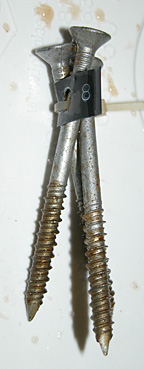
Stainless Steel
The stainless steel family consists of more than 100 alloys. Certain types of stainless steel are more corrosion-resistant. Most of the alloys are iron-based and contain at least 10 percent chromium, which is the element that gives stainless steel its stainless characteristics. The 18/8 stainless steel covers several types of stainless steel alloys in the 300 series. The 18/8 designation is 18 percent chromium and 8 percent nickel. No metals, however, are completely corrosion proof, except for platinum and gold.The four basic types of stainless steel are martensitic, ferritic, austenitic, and precipitation hardening. Martensitic is in the 400 series and contains more carbon and less chromium than the 400 series ferritic type. When nickel is added and chromium is increased, the stainless steel becomes austenitic and is then part of the 200 and 300 series. Ferritic 400 series stainless steel is magnetic, has low carbon content, and contains 13 percent to 17 percent chromium. Precipitation hardening is a heat-treating process that relieves stress, thus increasing strength, ductility, and corrosion resistance by precipitating certain compounds. Precipitation-hardened stainless steel is similar to martenistic stainless steel and exhibits high strength and hardness from heat-treating.
Passivation is an important factor in the corrosion resistance of stainless steel. Passivation removes iron compounds from the surface of stainless steel through a chemical surface-cleaning process. According to testing and galvanic reaction charts, passivated stainless steel surfaces are less corrosive then non-passivated.
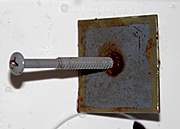
Hot-dipped Galvanized
Hot-dipped galvanized fasteners are recognized by building codes for use in ACQ applications. However, hot-dipped galvanized is not used on screws with head recesses such as Phillips due to "head fill" and therefore is not available on these types of screws. Even hot-dipped galvanized fasteners exhibit corrosion during testing and field use when moisture and copper are present. The amount of corrosion depends on the exposure parameters and may be acceptable depending on the application. The galvanic series chart ranking shows galvanized steel to be at the corrosive reactivity end of the chart, and passivated 300 and 400 series stainless steel to be at the opposite end of the chart. This indicates the resistance to corrosion with this type of fastener. All the unanswered questions and issues in regards to corrosion and fasteners used in ACQ applications has led some fastener manufactures to conduct corrosion research using ACQ wood and fasteners.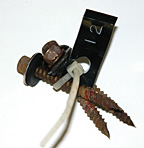
Research Questions
Industry leaders continue to probe for answers to several questions. What types of fastener material or coatings provide the most corrosion protection in ACQ applications? What impact on corrosion resistance do the different stainless steel alloys have? How much corrosion can a fastener or deck have without a negative impact on fastener pullout and wind uplift resistance? What test protocol is appropriate for testing ACQ corrosion? Is the life of the fastener or steel deck in regards to wind uplift resistance affected by corrosion due to ACQ wood preservative? The first step to designing a test that addresses some of these basic questions is to determine the critical variables, prepare an accelerated life test protocol and expose the samples to an extreme environment.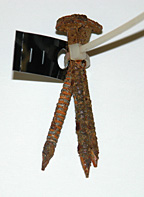
Testing Method
Several methods have been used to evaluate fasteners that will be in contact with ACQ-treated wood, but there is no standardized test in place to determine the amount of corrosion when a fastener is exposed to ACQ-treated wood. Typical standardized corrosion tests are salt spray and Kesternich acid resistance test. Though fastener corrosion has been tested for years using the salt and acid tests, these tests do not expose the fasteners to ACQ chemistry.The ACQ extract test was used in these experiments because several variables needed to be taken into account. First, one must drive the fastener into wood to achieve the potential of removing any coating. The fastener was removed from the wood to allow for maximum ACQ chemical exposure. The ACQ chemistry was directly extracted from the ACQ-treated wood by preparing a solution from ACQ wood chip leach-out achieving a conductivity reading of ACQ 0.420 uS (+/-10 percent).
The fasteners were submerged into the ACQ extract solution to ensure full exposure. The ACQ extract solution was aerated to keep the solution churning and ensure oxygen was present in the system to facilitate oxidation. Testing was conducted to evaluate fastener and steel deck resistance to corrosion and the impact on pullout after the deck and fastener were exposed to ACQ extract. A total of 54 fasteners were submerged into the test tank. Eighteen designs of different coatings and fastener materials were tested. Baseline pullouts were measured on fasteners that were not exposed to ACQ extract. Corrosion and pullout were evaluated after fasteners were exposed to 30 days in the ACQ extract corrosion test.
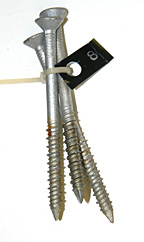
Results
Pullout testing conducted on the fasteners that were not exposed to corrosion showed a variety of results since the fasteners had different thread forms and in some cases diameters. The importance of the pullout data was to measure any differences between the fastener pullout with no corrosion and pullout after the deck and fasteners were exposed to the corrosion test. Fastener pullout conducted in steel deck that was also exposed to the ACQ extraction was reduced by 34 percent because the steel deck corroded around the screw with both carbon steel and stainless steel fasteners.
Fastener surfaces displayed a wide spectrum of results from no corrosion, small amounts of corrosion and massive corrosion. Even certain coated stainless steel alloys had a variety amount of corrosion. In general, stainless steel of the 300 and 400 series performed well. The 410 series stainless steel with specific proprietary coatings also did well. In some cases particular coatings seemed to allow more corrosion than others. Some types of uncoated stainless steel did extremely well, however, one must consider the other detriments such as salt spray and Kesternich acid resistance test, which means coating stainless steel may not be needed for ACQ but is needed for protection against the other elements. Some types of carbon steel with proprietary coatings had very low amounts of corrosion. Hot-dipped galvanized was covered with corrosion and so were the bi-metal samples.
Conclusions
ACQ-treated wood replaced CCA and test results have shown that there is an impact on corrosion that must be addressed. Wood preservative research is underway to improve the formula, however, in the meantime, roofing contractors must use the ACQ-treated wood that is currently available or resort to using untreated wood. Deck-to-fastener pullout was reduced by 34 percent regardless of fastener material or coating because the steel deck corroded when exposed to ACQ extract testing. The 300 series stainless did have good results as long as it was stand alone (non bi-metal), however, 410 showed slightly better results than the 300 alloy type tested. Hot-dipped galvanized nails and bi-metal screws experienced 95 percent full surface corrosion. Careful selection of coating is critical to corrosion resistance. The coating and fastener material must withstand exposure to ACQ, salt spray and Kesternich acid.
Fastener manufactures such as ITW Buildex are offering solutions. 410 stainless steel ACQ-resistant proprietary coating and durable proprietary coated carbon steel proved to be the most corrosion-resistant according to the ACQ extract test. Although in many cases the corrosion observed in this testing was only surface corrosion, many contractors are uncomfortable using fasteners that accumulate large areas of surface corrosion. Corrosion testing needs to be standardized for ACQ corrosion potential. The ACQ extract testing is an accelerated corrosion test performed in extreme conditions.
GALVANIC SERIES CHART
CORRODED END (ANODIC OR LEAST NOBLE)ZINC
GALVANIZED STEEL
ALUMINUM
CADMIUM
MILD STEEL (1018), WROUGHT IRON
STAINLESS STEEL, 430 SERIES (ACTIVE)
302, 303, 304, 321, 347, 410, 416, STAINLESS STEEL (ACTIVE)
NI - RESIST
316, 317, STAINLESS STEEL (ACTIVE)
LEAD
TIN
INCONEL 600 (ACTIVE)
NICKEL (ACTIVE)
BRASSES
COPPER (CA102)
MANGANESE BRONZE, TIN BRONZE
SILICON BRONZE
NICKEL SILVER
COPPER - NICKEL ALLOY
430 STAINLESS STEEL
NICKEL (PASSIVE)
302, 303, 304, 321, 347, STAINLESS STEEL (PASSIVE)
316, 317, STAINLESS STEEL (PASSIVE)
CARPENTER 20 CB-3 STAINLESS (PASSIVE), INCOLOY 825
NICKEL-MOLYBDEUM-CHROMIUM-IRON ALLOY (PASSIVE)
SILVER
TITANIUM
GRAPHITE
ZIRCONIUM
GOLD
PLATINUM
PROTECTED END (CATHODIC OR MOST NOBLE)
Looking for a reprint of this article?
From high-res PDFs to custom plaques, order your copy today!


